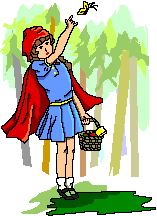|
 THE
FAIRY TALE: THE
FAIRY TALE:
Literary Analysis for All
Ages
Directions: The following assignments
should be completed on your own notebook paper with a correct
heading for each assignment. Staple assignments to your cover
page in order. Be prepared to share your writing. There will
be an in-class essay at the end of this mini-unit.
- Journal: Freewrite for five minutes about “Stories
I Heard/Read As a Child.” These stories may be books, cartoons,
movies, family stories -- whatever impressed you as a child.
- Brainstorming: List as many fairy tales as you can
remember. At this point, don't worry about whether you remember
details about any of the stories. Quantity is what counts --
the more the better!
- Classification: Examine your personal list and the
class list on the board. Think of a logical system for dividing
these fairy tales into at least three groups. Make a chart showing
each group and listing at least three fairy tales which fit in
each of your categories.
- Directed Freewrite: Select a fairy tale you remember
well. During the time allotted in class, jot down everything
you can recall -- names of characters, descriptions, setting,
specific dialogue, etc. Don't worry about complete sentences,
spelling, capitalization, punctuation, or even the order in which
you write. Be fluent. Get everything on paper!
- Synopsis: Read over your freewriting, underlining
the most important details to include in a summary. Tell “what
happens” in the fairy tale -- the 5 W’s and H (Who, What,
When, Where, Why, and How). Write this as a one-paragraph summary,
as a list which answers the 6 questions, or as a free-verse poem.
- Theme Statement: Every fairy tale teaches a lesson
-- not just “what happens” but “what it means.” In one carefully planned sentence, state the lesson (or moral
or theme) of your fairy tale.
- Analysis: Discuss the various fairy tales within your
group. Try to determine elements common to all of the stories.
What can say about characters, plot, setting, and theme in a
typical fairy tale?
- Application: Explain how a fairy tale differs from
a nursery rhyme, a legend, and a myth. Consider what you have
learned from these assignments, your reading, lecture, and class
discussion. Use examples.
- Synthesis / Creation: Choose one of these assignments
--
A. Rewrite one of the fairy tales in first-person point of view.
Use “I” and assume the persona of a character in the
story OR create a character who observes the story from the outside.
B. Modernize one of the fairy tales. Use contemporary settings,
language, and character types -- but generally stick to the original
plot and theme.
C. Change the form of one of the fairy tales -- a parody, poem,
advertisement, news story, letter, cartoon, script, rap, etc.
D. Write an original fairy tale.
- Evaluation: You will be given several one-paragraph
composition assignments to complete in class. These will include
A. Who is the most important character in ___________________?
B. How is ____________________ like ______________________?
C. What is the effect of the difference in the two versions of_______________________?
Ms.
Effie’s Fairy Tale Unit
|